Amanita phalloides: The Death Cap Mushroom

This exhibit uses materials from the Farlow Library, Archives, and Herbarium of Cryptogamic Botany to illustrate the varied representations of Amanita phalloides in literature, illustration, and specimens, dating from 1727 through the present.
Introduction
-
"NO MUSHROOM is worthier of fear than the terribly poisonous Death Cap (Amanita phalloides). This single, widespread species of mushroom is solely responsible for the majority of fatal and otherwise serious mushroom poisoning cases, worldwide as well as in North America. Indeed, one might argue that the Death Cap's notorious, relatively frequent victimization of Homo sapiens is far and away the best explanation (or rationalization) for the widespread fear of edible wild mushrooms."
- Amanita phalloides- The World's Most Dangerous Mushroom. Written and produced by David. W. Fischer
Amanita phalloides, commonly known as the death cap, is a recent addition to our shores. It is a mycorrhizal fungus, often found growing in association with the roots of oak trees.
Like other Amanitas, A. phalloides has a sack-like volva around its base and an annulus, or skirt-like ring, around the top of it's stalk. The gills are white or cream and the spores are white. The cap is either slightly greenish yellow or white and is relatively clean, without the scattered articles that many of the other species of Amanita exhibit. As they age A. phalloides also exhibits a foul almost sickly-sweet smell.
A. phalloides is not indigenous to the United States. There is a debate over exactly how and when it arrived but many scientists believe that it was brought into the U.S. from Europe, carried among cork or oak tree seedlings imported into California, and has since adapted to our native oaks. In the area north of Rochester, New York it was first discovered in the 1970s under Norway spruce that had been imported as nursery stock decades earlier. It has since been found in increasing numbers, under oaks native to the New York area.
Naming

One of the earliest representations of Amanita phalloides. It is identified as Fungus phalloides.
1727
Sébastien Vaillant (1669-1722)
Botanicon Parisiense, Ou, Denombrement Par Ordre Alphabetique Des Plantes Qui Se Trouvant Aux Environs De Paris ...
Leide: J. & H. verbeek, 1727.
Table XIV, figure 5 - Fungus phalloides
Vaillant was born at Vigny, Val d'Oise, France. He studied medicine at Pontoise, and then moved to Paris to practice as a surgeon, where he studied botany at the Jardin des Plantes under Joseph Pitton de Tournefort.
Vaillant was appointed to the staff of the Jardin des Plantes in 1702, becoming sub-demonstrator of plants in 1708. He took many botanical excursions, notably along the coasts of Normandy and Brittany. Apart from his fieldwork he concentrated on careful dissections of plants. His premature death prevented the publication of some of his manuscripts, notably his inaugural lecture in which he presented irrefutable evidence on the existence of plant sexuality. He was the first in France to promote the theory of sexuality of plants. When he was near death he gave his notes and plates to Herman Boerhaave for publication. In 1727 Boerhaave published Botanicon Parisiense, the culmination of thirty-six years of Vaillant's botanical research. This theory on plant sexuality influenced Linnaeus, who regarded Vaillant as one of the most important botanists.
 Another early and important appearance of Amanita phalloides. Persoon classifies it as amanita but gives it the name Amanita viridis.
Another early and important appearance of Amanita phalloides. Persoon classifies it as amanita but gives it the name Amanita viridis.
1797
C. H. (Christiaan Hendrik) Persoon (1755-1837)
Tentamen Dispositionis Methodicae Fungorum In Classes,Ordines, Genera Et Familias. Cum Supplemento Adjecto.
Lipsiae: P.P. Wolf, 1797.
Amanita viridis Pers.
Christiaan Hendrik Persoon was born at Stellenbosch, South Africa, in 1762 and died in Paris on November 16, 1836, aged 74 years. Much information about Persoon’s life is unknown.
Persoon was orphaned at an early age, sent to Germany, and afterwards settled in Paris. Persoon attended the University of Leyden and Gottingen and became a doctor of medicine. While in medical practice he devoted his spare time to botany and published several valuable textbooks on fungi. Persoon's Synopsis Methodica Fungorum (1801) is an epic work on fungal systematics. "We have always been a sincere admirer of the works of Persoon and considered him not only the 'Father of Mycology' but the greatest genius that ever worked on the subject." (C.G. Lloyd, 1924).
 1821 The amanita is now called Agaricus phalloides.
1821 The amanita is now called Agaricus phalloides.
Elias Magnus Fries (1794-1878)
Systema Mycologicum : Sistens Fungorum Ordines, Genera Et Species, Huc Usque Cognitas, Quas Ad Normam Methodi Naturalis Determinavit, Disposuit Atque.
Lundæ: ex officina Berlingiana, 1821-32.
Agaricus phalloides Vaill. ex Fr.
Elias Fries was born 1794 in the village Femsjö in the western part of the province Småland in southern Sweden. According to Fries, his great interest in fungi started when he as a twelve year old boy came across a magnificent specimen of Hericium coralloides. Already as a schoolboy he knew between 300 and 400 species of fungi, to which he gave provisional names. He started his university studies in Lund in 1811 and obtained his doctor's degree there in 1813.
Fries's most important work was Systema Mycologicum, issued in three volumes between 1821 and 1832. It has for a long time, together with Elenchus Fungorum from 1828, been the starting point for fungal names and today the names in it are sanctioned. In 1834 Fries was appointed professor in Uppsala and from then on his main interest was the Hymenomycetes.
Elias Fries is often referred to as the father of mycology.
 1833 The name Amanita phalloides appears for the first time in mycological literature.
1833 The name Amanita phalloides appears for the first time in mycological literature.
Heinrich Friedrich Link (1767-1851)
Handbuch Zur Erkennung Der Nutzbarsten Und Am Häufigsten Vorkommenden Gewächse.
Berlin: Spenerschen Buchhandlung, 1829-1833.
Amanita phalloides (Vaill. ex Fr) Link
Heinrich Friedrich Link was born in Hildesheim, Germany, in 1767. In 1786 he entered the University of Gottingen where he studied medicine with frequent deviations towards the natural sciences. In 1792 Link was nominated for the position of chair of natural history and chemistry at the University of Rostock. He remained there for twenty years and during his tenure published many botanical works.
In 1811 Link was asked to fill the chair of natural history at both Halle and Breslau; he chose Breslau. He remained there for 4 years and then was then appointed professor of botany at Berlin and director of the university's botanic garden. Link was an early promotor of a general knowledge of plants, and combined anatomical and physiological enquiries with solid research in systematic botany.
Images
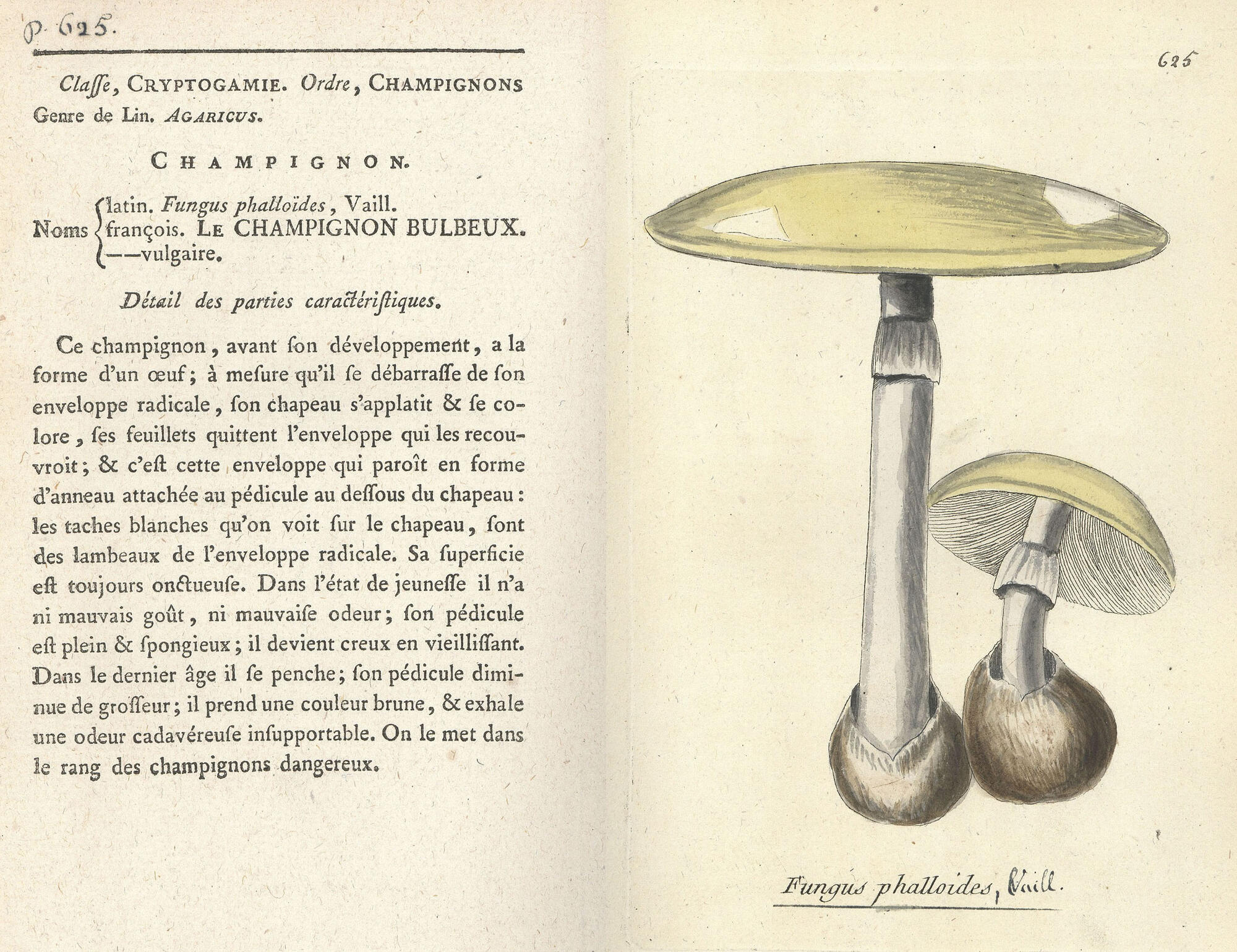
1783
Pierre Bulliard (1752-1793)
Flora Parisiensis : Ou, Descriptions Et Figures Des Plantes Qui Croissent Aux Environs De Paris.
Paris: P.F. Didot, 1776-1783.
Farlow Library of Cryptogamic Botany
Plate 625 - Fungus phalloides Vaill.
Jean Baptiste Francois Bulliard, (1752-1793) [Pierre Bulliard] was born in Aubepierre, France on November 24, 1752. He studied medicine in Langres, and in hospices in Clairvaux and Paris, where he set up his own practice. Bulliard began his botanical studies at the Abbey of Clairvaux and was a pupil of Jean Jacques Rousseau. He became one of the foremost French botanists of the eighteenth century.
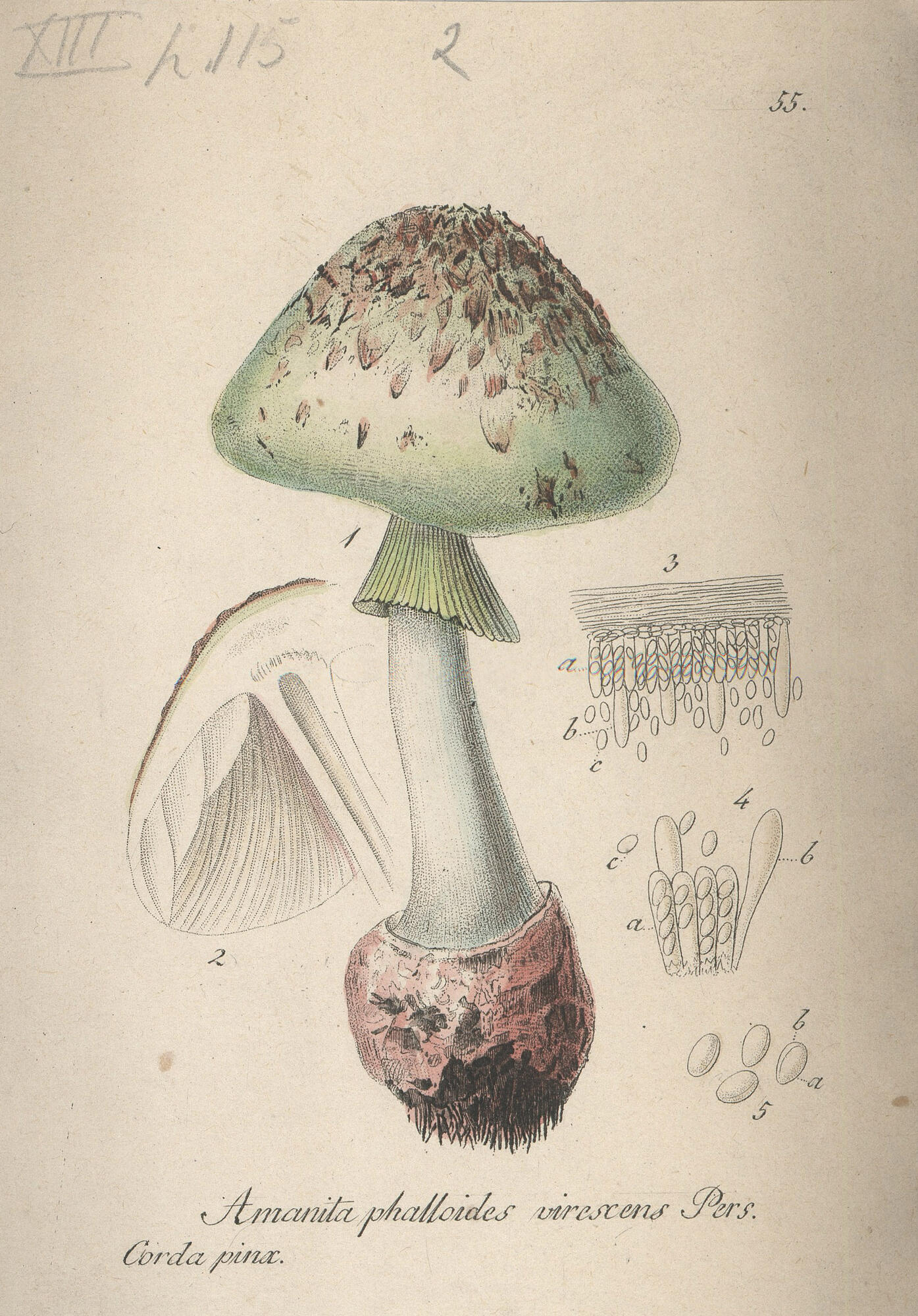 1817
1817
Joseph Sturm (1771-1848)
Deutschlands Flora In Abbildungen Nach Der Natur Mit Beschreibungen.
Nurnberg: Gedruckt auf kosten des verfassers, 1798-[1862]
Farlow Library of Cryptogamic Botany
Plate 35 - Amanita phalloides virescens Pers.
Jakob Sturm (1771-1848) was born in Nuremberg, Germany, the only son of engraver Johann Georg Sturm. He received only a modest formal education before entering his apprenticeship under his father, who trained him in the art of drawing and copperplate engraving.
Sturm is considered by some to be the most famous engraver of entomological and botanical publications in Germany at the end of the 18th and beginning of the 19th century. Sturm's plates are very delicately drawn and depict the smallest details. They enjoyed a great popularity among naturalists. He deliberately chose a minute format in order to make knowledge of the German flora available by pictures to as many as possible and as cheaply as possible.
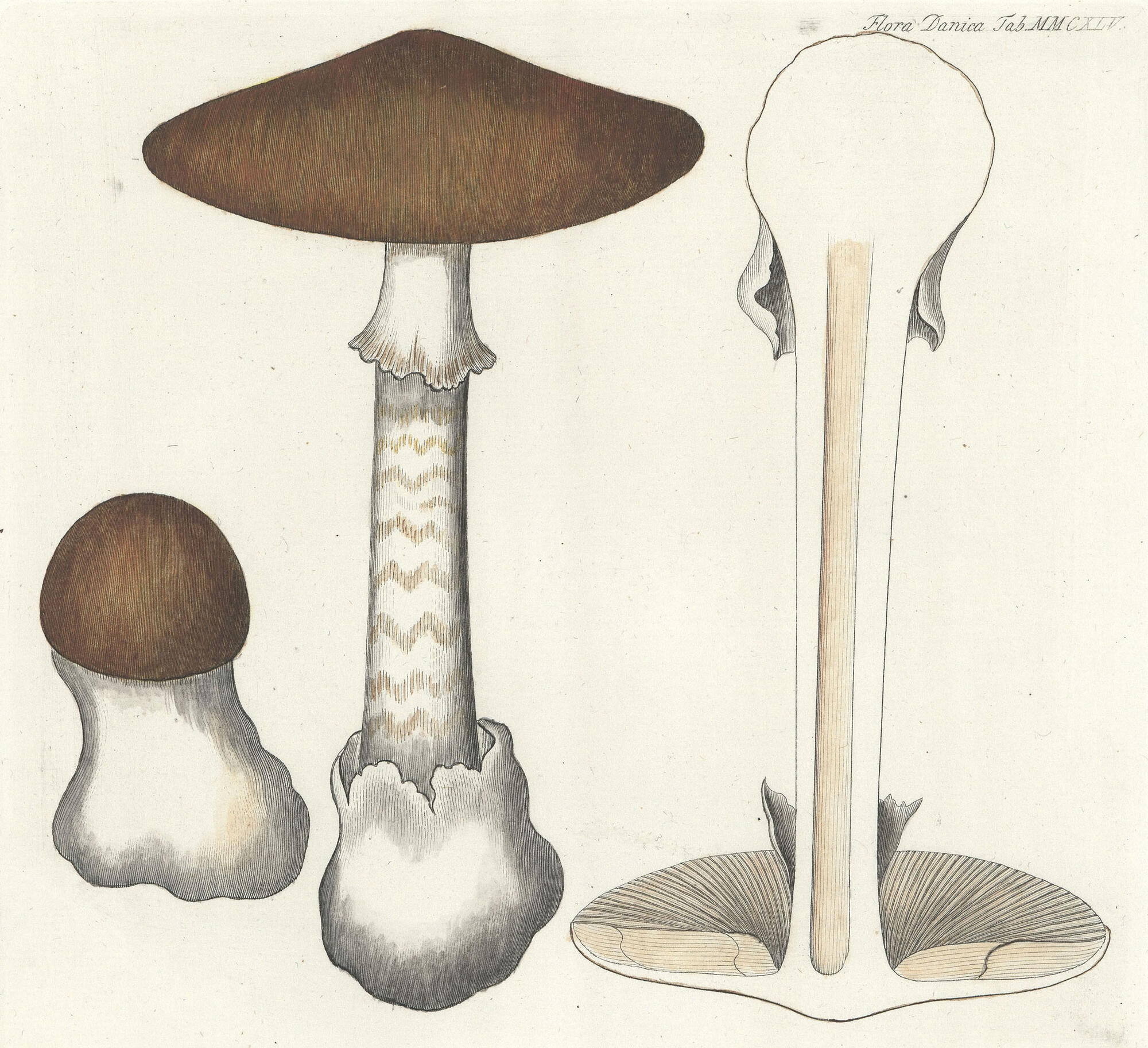
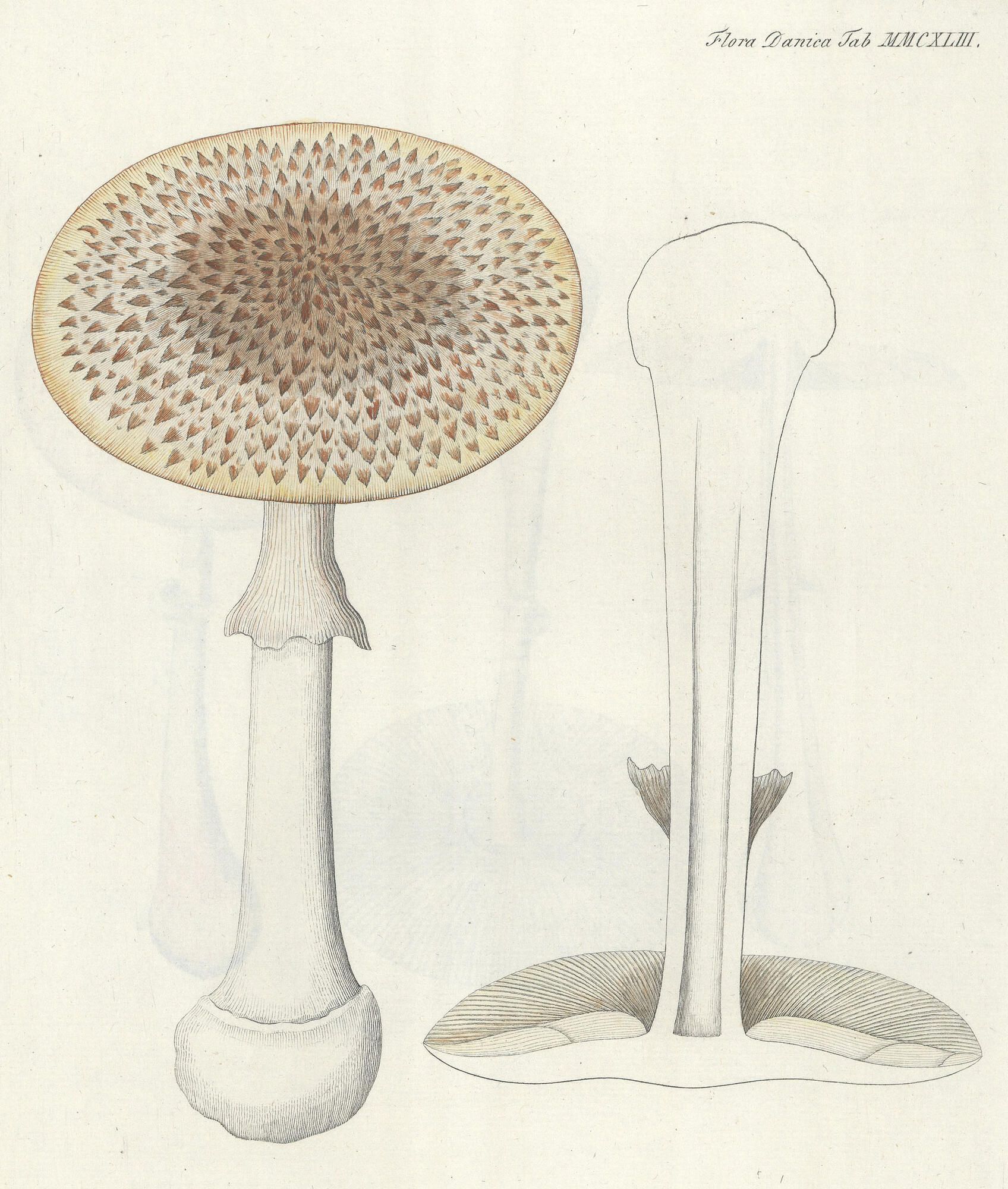
1834
[Flora Danica].
Icones Plantarum Sponte Nascentium In Regnis Daniæ Et Norvegiæ, In Ducatibus Slesvici Et Holsatiæ.
Hafniæ, typis [fratrum] C. [& A.] Philiberti, 1766 [i.e. 1761]-1883.
Farlow Library of Cryptogamic Botany
(L) Hæfte 36, Plate 2143 - Agaricus phalloides Horn.
(R) Hæfte 36, Plate 2145 - Agaricus phalloides Vaill. var.
In 1753 German botanist Georg Christian Oeder, then professor of botany at the Royal Botanical Institution in Copenhagen, proposed the publication of a Flora Danica with folio-sized pictures of all wild plants in Denmark. The aim was to popularize botany and in that way enhance the knowledge of the useful and harmful characters of the various plants. The first part of the book was published in 1761 (ahead of schedule) and the last part was published 113 years later in 1874. Oeder was fired as editor in 1772 and replaced by the zoologist O.F. Müller. Following him, 11 different botanists were in charge of publishing Flora Danica.The plates appeared in a hand-painted edition and a cheaper plain one. The bulk of the work consists of 51 parts + 3 supplements, containing 3240 copper engraved plate.

1840
Harald Othmar Lenz (1799-1870)
Die Nützlichen Und Schädlichen Schwämme, Nebst Einem Anhange Über Die Islandische Flechte.
2. Aufl.
Gotha: Becker, 1840.
Farlow Library of Cryptogamic Botany
Taf 1, 1 - Agaricus phalloides
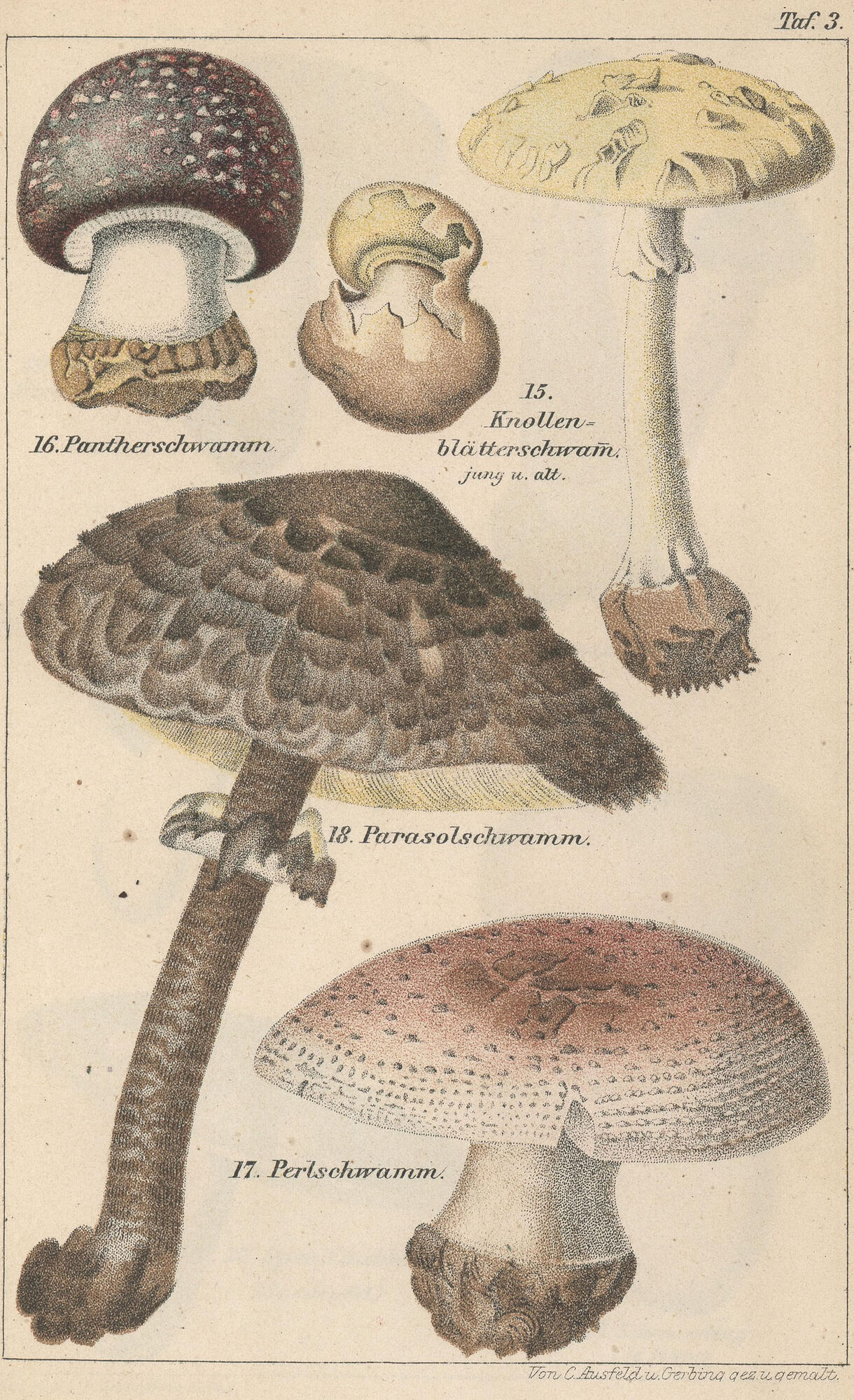
1874
Harald Othmar Lenz (1799-1870)
Die Nützlichen Und Schädlichen Schwämme, Nebst Einem Anhange Über Die Islandische Flechte.
5. Aufl.
Gotha: Thienemann, 1874.
Farlow Library of Cryptogamic Botany
Knollenblatterpilz = Amanita phalloides
Taf 3, 15 - Knollenblatterpilz

1859
J. B. (Jean Baptiste) Barla (1817-1896)
Les Champignons De La Province De Nice.
Nice: Impr. Canis Frères, 1859.
Farlow Library of Cryptogamic Botany
Barla was a well known French mycologist and the director of the Natural History Museum at Nice. Beginning in 1840, Barla casted thousands of wax models of mushrooms.
Plate 4 - Agaricus phalloides Fries.
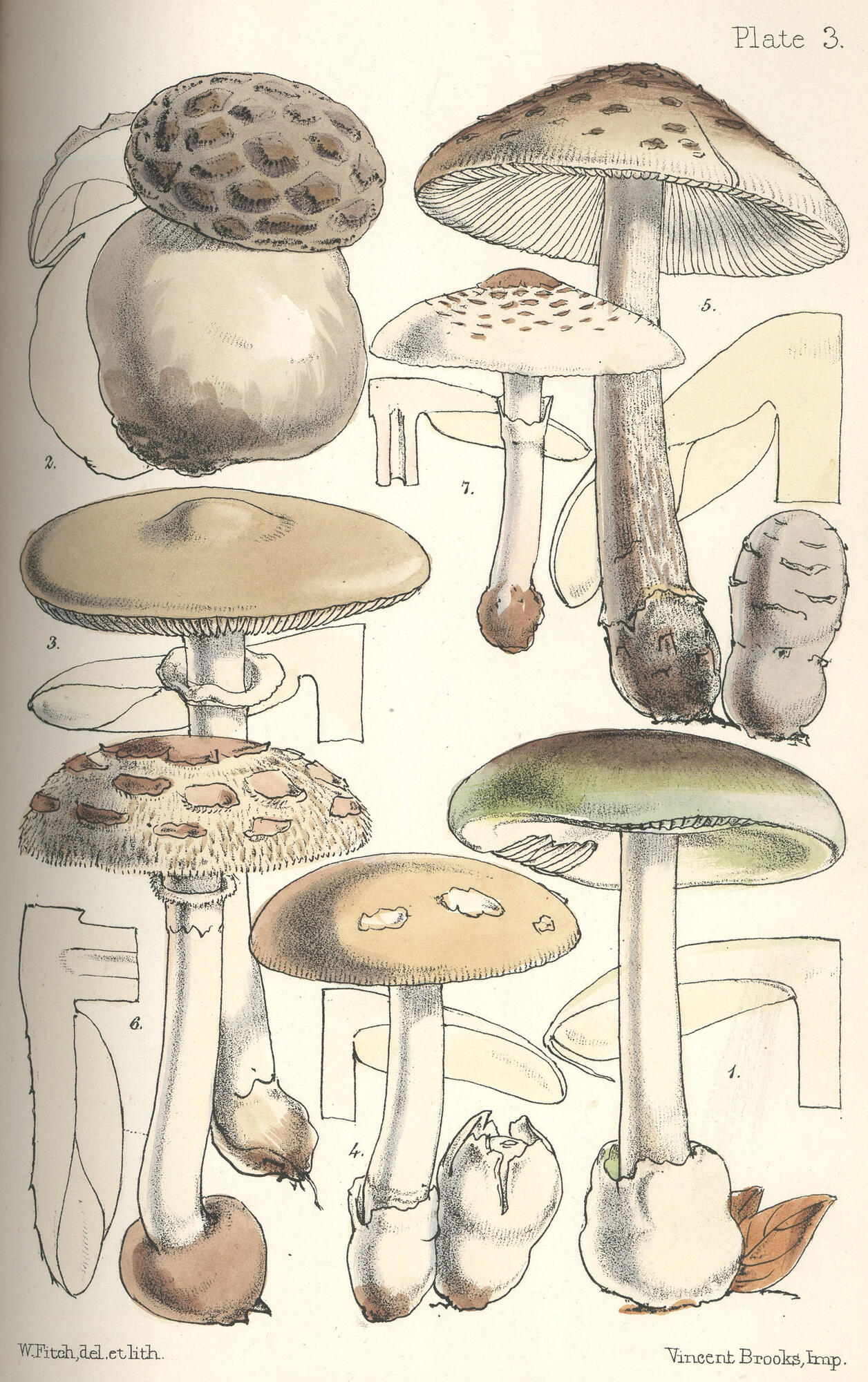
1860
Rev. M. J. (Miles Joseph) Berkeley (1803-1889)
Outlines Of British Fungology.
London: L. Reeve, 1860.
Farlow Library of Cryptogamic Botany
Plate 3, figure 1 - Agaricus phalloides
Miles Joseph Berkeley was born in Northamptonshire, England on 1 April 1803. He became attracted to natural history from an early period, and his scientific tendencies, both zoological and botanical, were kept alive and vigorous while he was at Christ's College, Cambridge. During summers in Scotland (Loch Lomond in 1823 and Oban in 1824), he made considerable collections of specimens of animals and plants.
Mr. Berkeley was admitted as a deacon and curate of Stibbington, near Wansford, on December 1, 1826, and here he was ordained a priest on December 23, 1827. During this time he made many drawings of fungi and began to publish his numerous cryptogamic publications.
In 1879 he was elected fellow of the Royal Society, and shortly after presented his extensive collection of fungi, amounting to upwards of 10,000 species, to Kew. It has been estimated that the collection contains 4,866 type specimens named by himself, and that Berkeley must have named a total of nearly 6,000 species.
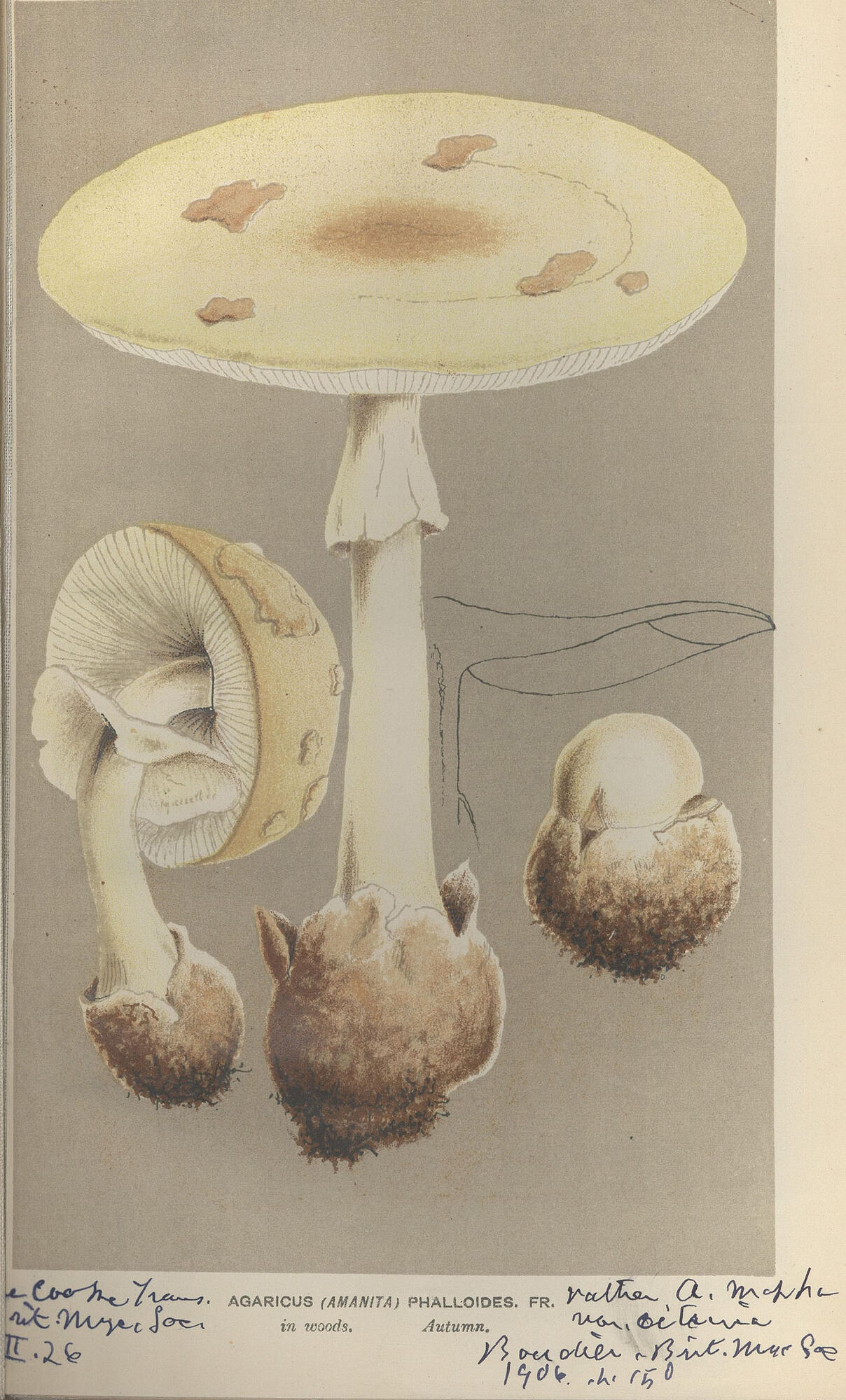
1881-1883
M. C. (Mordecai Cubitt) Cooke (1825-1914)
Handbook Of British Fungi, With Full Descriptions Of All The Species.
London, New York: Macmillan and co., 1871.
Farlow Library of Cryptogamic Botany
Mordecai Cubitt Cooke (1825-1914) was a British mycologist and phycologist at the India Museum (1861-1880) and the Royal Botanic Gardens, Kew (1880-1892). He made important studies in Australia and Great Britain and wrote and illustrated natural history books and journals. Cooke sold his popular magazine Science Gossip in order to produce the more scientific publication Grevillea. He also wrote the popular early account of psychopharmacology The Seven Sisters of Sleep in 1860.
Plate 2 - Amanita phalloides note at bottom of plate written by Farlow.

circa 1890s
Joseph Bridgham (1845-1915)
unpublished watercolor and pen & ink drawing
Farlow Archives of Cryptogamic Botany
Watercolor - incorrectly identified as Amanita phalloides pale form but probably Amanita mappa
Pen & Ink - identified as Amanita phalloides
Joseph Bridgham achieved recognition in the scientific world as an entomologist and a nature illustrator. Much of Bridgham's work was commissioned by the United States government, but he also worked for colleges and institutions throughout the United States and other countries. He worked with Professor William Farlow from 1889-1899 on the fungi of North America. During this period he also produced a set of illustrations of North America flowers for Columbia College in New York.
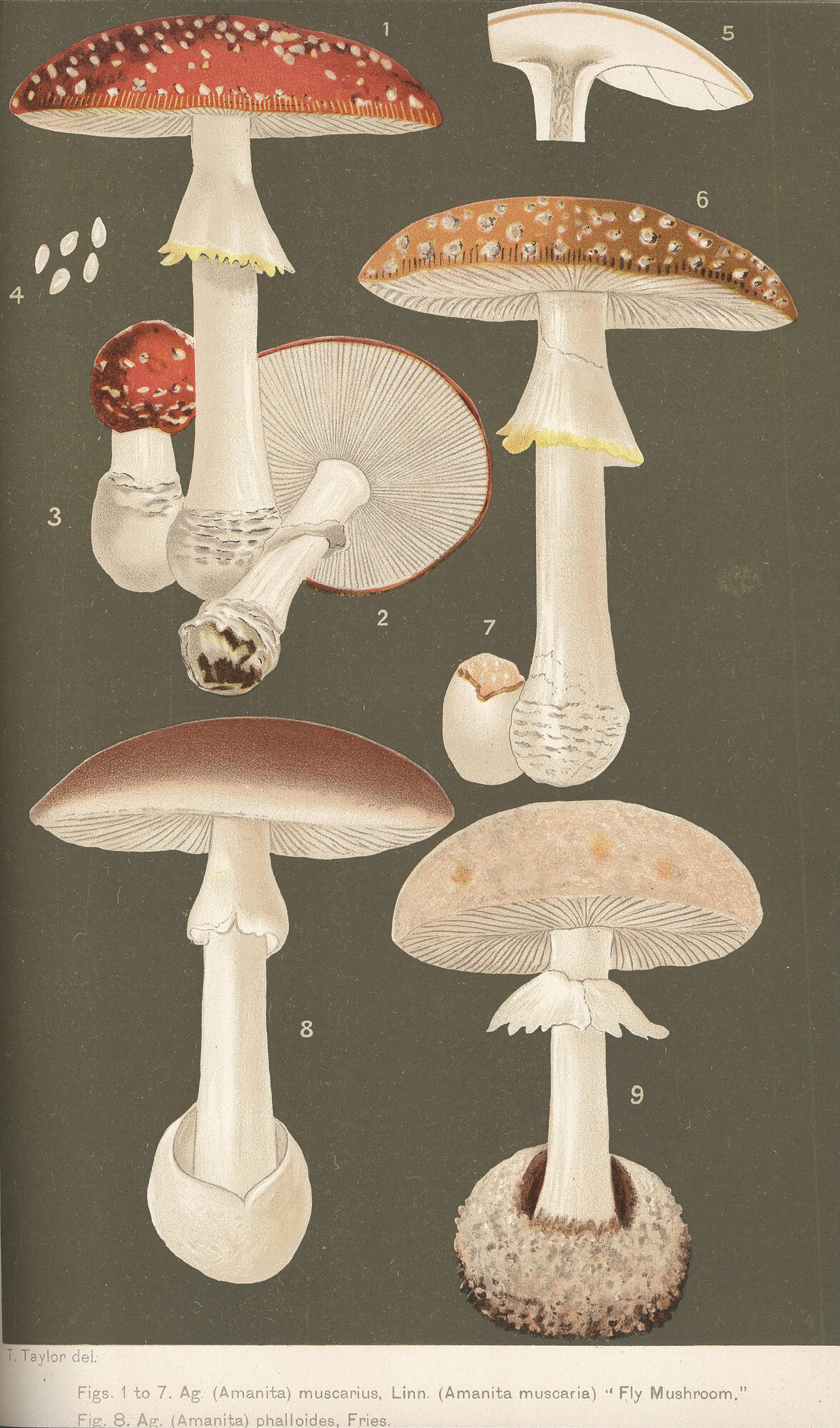
1897-1898
Thomas Taylor (1820-1910)
Student's Hand-Book Of Mushrooms Of America Edible And Poisonous.
Washington: A. R. Taylor, 1897-98
Farlow Library of Cryptogamic Botany
Thomas Taylor is credited with the introduction of plant pathology into federal agricultural research.
Born in Pertshire, Scotland, Taylor was interested and educated in a wide variety of subjects. He studied physics and chemistry at Glasgow University, art and drawing at the British School of design, and medicine at Georgetown University. His background in botany was largely self-taught.
Taylor was appointed to be the first microscopist to the United States Department of Agriculture in 1871. There he was responsible for the first USDA publications on microscopic plant pathogens. One of Taylor's particular interests was pathogenic fungi. He published several descriptions of edible and poisonous mushrooms, with recipes.Taylor was not particularly popular with his colleagues, and much of his work was disregarded due to his informal training in botany. Though his work in phytopathology was criticized for being small in scale, Taylor pursued his interests earnestly.
Plate XV, figure 8 - (Amanita) phalloides Fries.
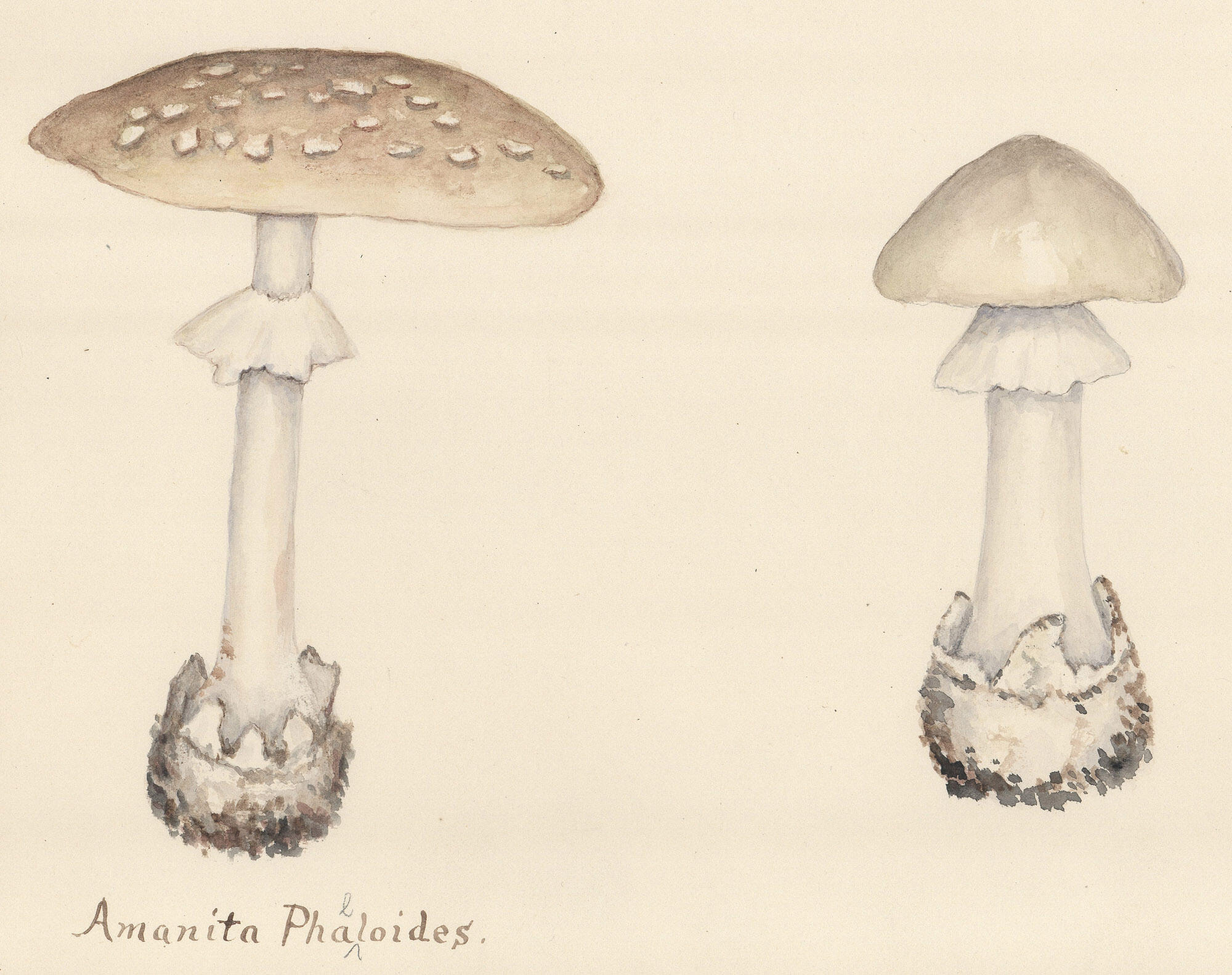
circa 1910
Lizzie C. Allen
unpublished watercolor
Farlow Archives of Cryptogamic Botany
Plate identified as A. phalloides but probably not (original watercolor from Farlow Archives).
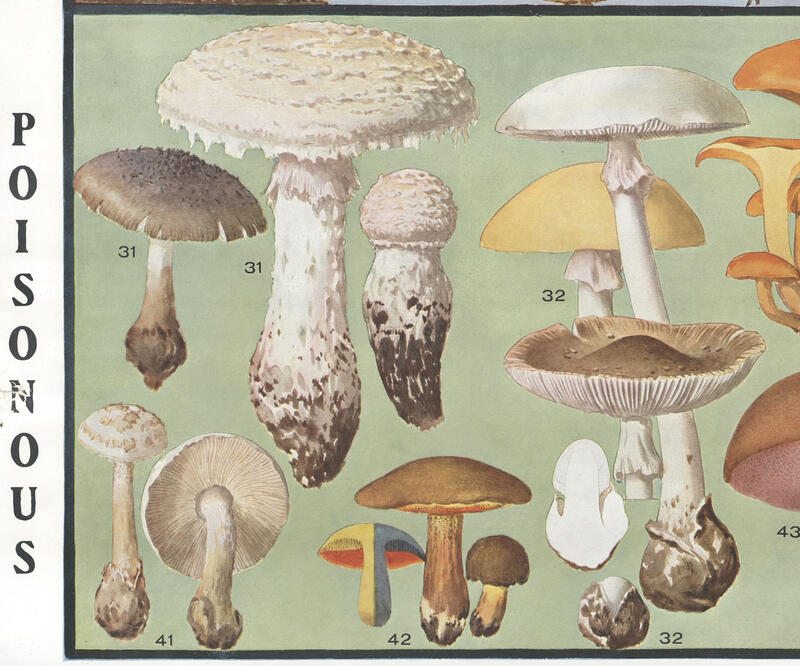
1916
William A. Murrill (1869-1957)
Edible and Poisonous Mushrooms.
New York: The author, 1916.
Farlow Library of Cryptogamic Botany
Figure 32 - Venenarius phalloides (Amanita phalloides).
William Alphonso Murrill was a mycologist, taxonomist, and writer, with a particular expertise in the Agaricales. He collected over 70,000 specimens of fungi in North and South America, and the Caribbean. Using the American Code of Botanical Nomenclature, Murrill identified and described many new genera and species as well as revising existing taxa. The bulk of his career was spent at the New York Botanical Garden. A prolific writer, Murrill published over five hundred scientific articles on a wide range of botanical subjects. He also founded and served as editor of Mycologia (1909-1924), edited the Journal of the New York Botanical Garden (1906-1908), and was a contributor to North American Flora. In 1924 he retired both from the NYBG and from professional life altogether. During the 1930's he became associated with the University of Florida in Gainesville, where he resumed mycological study and publication until his death in 1957.
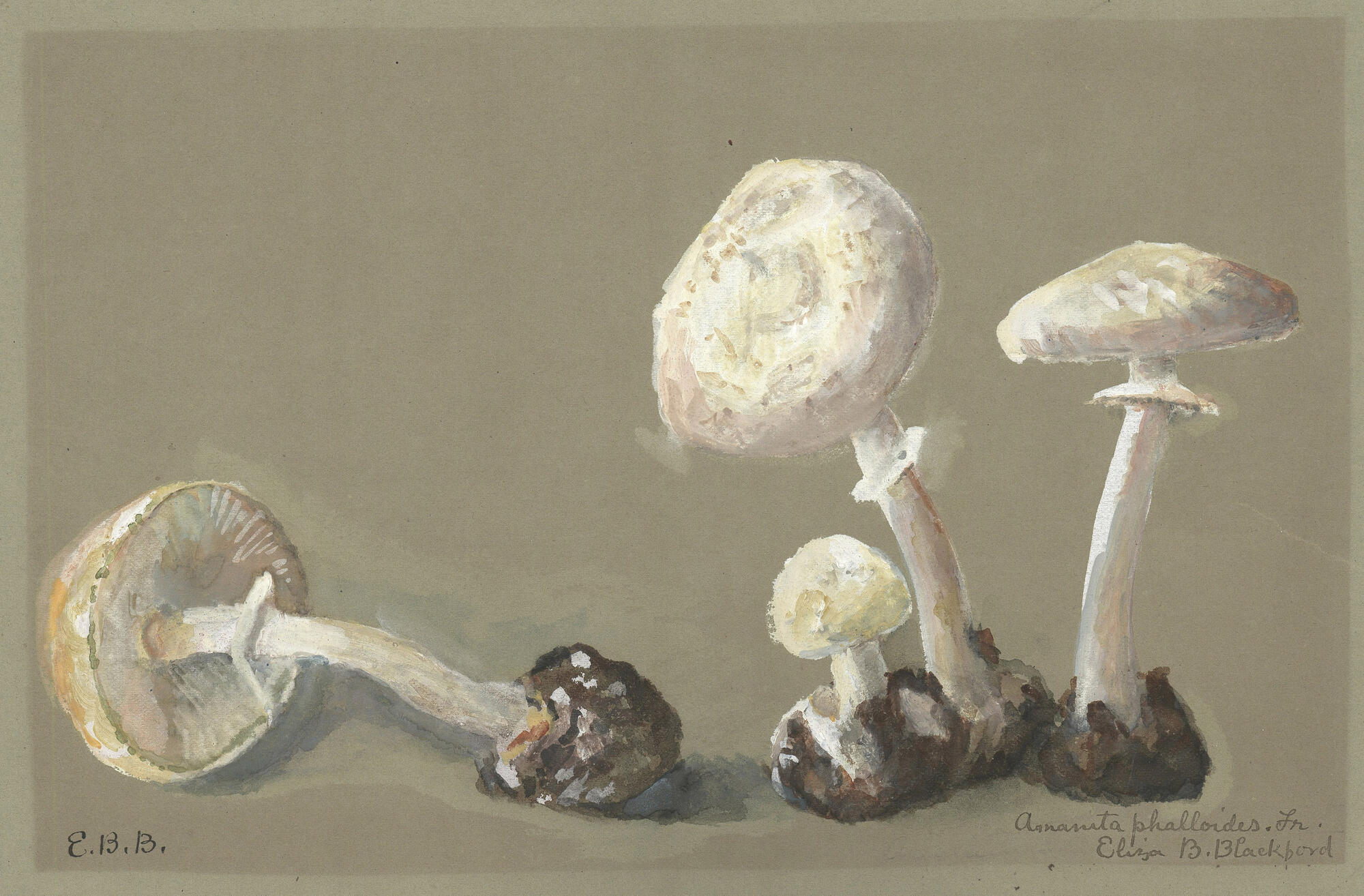
circa 1920s
Eliza B. Blackford (1857-1935)
unpublished watercolor
Farlow Archives of Cryptogamic Botany
Plate identified as A. phalloides but probably not accurate.
Eliza B. Blackford was born Eliza B. Larsh in Eaton, Ohio in 1847. She was educated in the public schools there and married a classmate, Levi Blackford. Her husband became a minister and they moved to Boston where she began to study drawing and painting under the best teachers at the School of the Museum of Fine Arts. When she graduated, she had pupils of her own and was a substitute teacher at the school. Eventually she joined the staff of the Museum of Fine Arts where she stayed until her retirement in 1925. She travelled abroad and read French, German and Italian. She took a great interest in botany, particularly fungi. Besides working at the MFA, she was president of the Boston Mycological Club for several years and had four mushrooms named for her by Charles Peck, a leading mycologist of the time. She also belonged to the Massachusetts Horticultural Society, the Boston Malacological Club, the Copley Society of Art, and the Ramblers Group of the Field and Forest Club. She died in January 1935 after a short illness, and left paintings and specimens to the Farlow Herbarium.
Poisoning
|
Amanita phalloides is colloquially known as the “Death Cap” mushroom. This is not without cause. According to the US Centers for Disease Control and Prevention, the majority of worldwide mushroom poisonings can be attributed to the amatoxins present in Amanita. The majority of Amanita poisonings are the result of misidentification by the forager/cook. Do not ingest any mushroom that has not been identified as safe by a professional. If you suspect poisoning, call your local emergency number (911 in the U.S.) or contact your local poison control center. The American Association of Poison Control Centers (800-222-1222) can direct you to a local center |
|||
|
|
|||
|
Selected case studies on Amanita phalloides poisoning. Vo, Kathy T. et al. 2017. Amanita phalloides mushroom poisonings — northern California, December 2016. Morbidity and Mortality Weekly Report. 66:549-553. Chan, Adam. 2019. Mushroom poisonings on the rise in 2019: BCCDC. CTV News. Food Safety News. 2019. Wild mushroom warning in Australia after poisoning cases. Keller, S.A. et al. 2018. Mushroom poisoning—A 17 year retrospective study at a level I university emergency department in Switzerland. International Journal of Environmental Research and Public Health. 15: 2855.
|
Pop Culture
Mushrooms in general have long appeared in art, literature, and legend. Often the species of fungi is not identified, and when Amanita shows up, it’s often A. muscaria, the flashier relative of A. phalloides. Because of its deadly nature, A. phalloides sometimes appears in crime fiction. In Ruth Rendell’s short story “Shreds and Slivers” (1994) a man plots revenge against his wife. Kate Atkinson slips a few bits of A. phalloides into a man’s soup in Human Croquet (1997). And in legend, any number of notables were supposedly poisoned by A. phalloides.
For more information on mushroom poisoning in fiction and legend, see R. Gordon Wasson’s "The Case for Claudius or Mushrooms for Murderers" published in Botanical Museum Leaflets in 1972